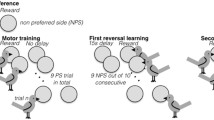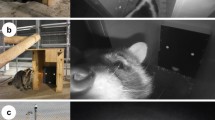Abstract
Increasingly, researchers are moving animal cognitive research into wild field settings. A field-based approach offers a valuable complement to laboratory-based studies, as it enables researchers to work with animals in their natural environments and indicates whether cognitive abilities found in captive subjects are generalizable to wild animals. It is thus important to field-based research to clarify which cognitive tasks can be replicated in wild settings, which species are suitable for testing in the wild, and whether replication produces similar results in wild animals. To address these issues, we modified a well-known lab test for field applications. The transfer index (TI) is a reversal learning task that tests whether animals rely on more associative or rule-based learning strategies (Rumbaugh in Primate behavior: developments in field and laboratory research. Academic Press, Inc., New York, pp. 2–66, 1970). In this paper, we detail changes needed to use a TI-like task in the field, here referred to as the Field Reversal Index (FRI). We tested a sample of nine wild vervet monkeys (Chlorocebus pygerythrus) on the FRI task at Lake Nabugabo, Uganda. We show that wild primates can successfully be tested on reversal learning paradigms, and present findings that reinforce previous conclusions from captive experiments. Our results indicate that vervets, like other cercopithecoids, rely on associative learning rather than rule-based learning. Further, our results are consistent with previous research that reports improved performance post-reversal in younger individuals relative to older individuals. The FRI enables researchers to test animals both in the wild and in captivity to facilitate direct comparisons between the learning abilities of captive and wild animals.





Similar content being viewed by others
References
Bates D, Maechler M, Bolker B, Walker S (2015) Fitting linear mixed-effects models using lme4. J Stat Softw 64:1–48
Benson-Amram S, Holekamp KE (2012) Innovative problem solving by wild spotted hyenas. Proc R Soc B 279:4087–4095
Benson-Amram S, Weldele ML, Holekamp KE (2013) A comparison of innovative problem-solving abilities between wild and captive spotted hyaenas, Crocuta crocuta. Anim Behav 85:349–356
Beran MJ et al (2008) Discrimination reversal learning in capuchin monkeys (Cebus apella). Psychol Rec 58:3–14
Bergman TJ, Kitchen DM (2008) Comparing responses to novel objects in wild baboons (Papio ursinus) and geladas (Theropithecus gelada). Anim Cogn 12:63–73
Bolter DR, Zihlman AL (2003) Morphometric analysis of growth and development in wild-collected vervet monkeys (Cercopithecus aethiops), with implications for growth patterns in Old World monkeys, apes, and humans. J Zool 260:99–110
Bonte E, Kemp C, Fagot J (2014) Age effects on transfer index performance and executive control in baboons (Papio papio). Front Psychol 5:1–7
Boogert NJ, Reader SM, Laland KN (2006) The relation between social rank, neophobia and individual learning in starlings. Anim Behav 72:1229–1239
Bramblett CA (1980) A model for development of social behavior in vervet monkeys. Dev Psychobiol 13:205–223
Carere C, Locurto C (2011) Interaction between animal personality and animal cognition. Curr Zoo 57:491–498
Carter GG, Forss S, Page RA, Ratcliffe JM (2018) Younger vampire bats (Desmodus rotundus) are more likely than adults to explore novel objects. PLoS ONE 13:e0196889
Cauchoix M, Hermer E, Chaine AS, Morand-Ferron J (2017) Cognition in the field: comparison of reversal learning performance in captive and wild passerines. Sci Rep 7:12945
Cheney DL, Seyfarth RM (1983) Dispersal in free-ranging vervet monkeys: social and genetic consequences. Am Nat 122:392–412
De Lillo C, Visalberghi E (1994) Transfer index and mediational learning in tufted capuchins (Cebus apella). Int J Primatol 15:275–287
Dugatkin LA, Alfieri MS (2003) Boldness, behavioral inhibition and learning. Ethol Ecol Evol 15:43–49
Fischer B, Wegener D (2018) Emphasizing the “positive” in positive reinforcement: using nonbinary rewarding for training monkeys on cognitive tasks. J Neurophysiol 120:115–128
Fragaszy DM, Adams-Curtis LE (1991) Environmental challenges in groups of capuchins. In: Box H (ed) Primate responses to environmental change. Chapman and Hall, London, pp 239–264
Gazes RP, Brown EK, Basile BM, Hampton RR (2013) Automated cognitive testing of monkeys in social groups yields results comparable to individual laboratory-based testing. Anim Cogn 16:445–458
Greenberg R (2003) The role of neophobia and neophilia in the development of innovative behaviour of birds. In: Reader SM, Laland KN (eds) Animal Innovation. Oxford University Press, Oxford, pp 175–196
Guenther A, Brust V, Derse M, Trillmich F (2013) Learning and personality types are related in Cavies (Cavia aperea). J Comp Psychol. https://doi.org/10.1037/a0033678
Guillette LM, Reddon AR, Hoeschele M, Sturdy CB (2011) Sometimes slower is better: slow-exploring birds are more sensitive to changes in a vocal discrimination task. Proc R Soc B 278:767–773
Hanna DEL, Buck DG, Chapman LJ (2016) Effects of habitat on mercury concentrations in fish: a case study of Nile perch (Lates niloticus) in Lake Nabugabo, Uganda. Ecotoxicology 25:178–191
Horrocks JA (1985) Life-history characteristics of a wild population of vervets (Cercopithecus aethiops sabaeus) in Barbados, West Indies. Int J Primatol 7:31–47
Isden J, Panayi C, Dingle C, Madden J (2013) Performance in cognitive and problem-solving tasks in male spotted bowerbirds does not correlate with mating success. Anim Behav 86:829–838
Janson CH (2012) Reconciling rigor and range: observations, experiments, and quasi-experiments in field primatology. Int J Primatol 33:520–541
Judge PG, Evans DW, Schroepfer KK, Gross AC (2011) Perseveration on a reversal-learning task correlates with rates of self-directed behavior in nonhuman primates. Behav Brain Res 222:57–65
Kinoshita M, Ohta H, Matano S (1997) Age change in learning ability of Japanese monkeys (Macaca fuscata) measured by the transfer index. Psychol Rep 80:467–473
Kumpan LT, Rothman JM, Chapman CA, Teichroeb JA (2019) Playing it safe? Solitary vervet monkeys (Chlorocebus pygerythrus) choose high-quality foods more than those in competition. Am J Primatol e23002
Lupien SJ, McEwen BS, Gunnar MR, Heim C (2009) Effects of stress throughout the lifespan on the brain, behaviour and cognition. Nat Rev Neurosci 10:434–445
MacDonald SE, Ritvo S (2016) Comparative cognition outside the laboratory. Compar Cogn Behav Rev 11:49–61
Morand-Ferron J, Cole EF, Rawles JE, Quinn JL (2011) Who are the innovators? A field experiment with 2 passerine species. Behav Ecol 22:1241–1248
Morand-Ferron J, Hamblin S, Cole EF, Aplin LM, Quinn JL (2015) Taking the operant paradigm into the field: associative learning in wild great tits. PLoS ONE 12:e0133821
O’Hara M, Huber L, Gajdon GK (2015) The advantage of objects over images in discrimination and reversal learning by kea, Nestor notabilis. Anim Behav 101:51–60
Rangel-Negrin A, Alfaro JL, Valdez RA, Romano MC, Serio-Silva JC (2009) Stress in Yucatan spider monkeys: effects of environmental conditions on fecal cortisol levels in wild and captive populations. Anim Conserv 12:496–502
Rowe C, Healy SD (2014) Measuring variation in cognition. Behav Ecol 25:1287–1292
Rumbaugh DM (1969) The transfer index: an alternative measure of learning set. In: Proceedings of the 2nd International Primatological Society Congress, Atlanta
Rumbaugh DM (1970) Learning skills of anthropoids. In: Rosenblum L (ed) Primate behavior: developments in field and laboratory research. Academic Press Inc, New York, pp 2–66
Rumbaugh DM (1971) Evidence of qualitative differences in learning processes among primates. J Comp Physiol Psychol 76:250–255
Rumbaugh DM, Arnold RC (1971) Learning: a comparative study of Lemur and Cercopithecus. Folia Primatol 14:154–160
Rumbaugh DM, Gill TV (1971) The learning skills of great apes. J Hum Evol 2:171–179
Rumbaugh DM, Pate JL (1984) The evolution of cognition in primates: a comparative perspective. In: Roitblat HL, Bever TG, Terrace HS (eds) Animal cognition. Psychology Press, New York, pp 565–585
Schoenbaum G, Nugent S, Saddoris MP, Gallagher M (2002) Teaching old rats new tricks: age-related impairments in olfactory reversal learning. Neurobiol Aging 23:555–564
Seyfarth RM, Cheney DL (1986) Vocal development in vervet monkeys. Anim Behav 34:1640–1658
Sih A, Del Giudice M (2012) Linking behavioural syndroms and cognition: a behavioural ecology perspective. Phil Trans R Soc B Biol Sci 367:2762–2772
Struhsaker TT (1967a) Behavior of vervet monkeys (Cercopithecus aethiops). Univ Calif Publ Zool 82:1–64
Struhsaker TT (1967b) Social structure among vervet monkeys (Cercopithecus aethiops). Behaviour 29:83–121
Tapp PD, Siwak CT, Estrada J, Head E, Muggenburg BA, Cotman CW, Milgram NW (2003) Size and reversal learning in the beagle dog as a measure of executive function and inhibitory control in aging. Learn Mem 10:64–73
Teichroeb J (2015) Vervet monkeys use paths consistent with context-specific spatial movement heuristics. Ecol Evol 5:4706–4716
Thornton A, Samson J (2012) Innovative problem solving in wild meerkats. Anim Behav 83:1459–1468
Tomasello M, Call J (1997) Primate cognition. Oxford University Press, New York
Turner TR, Anapol F, Jolly CJ (1997) Growth, development, and sexual dimorphism in vervet monkeys (Cercopithecus aethiops) at four sites in Kenya. Am J Phys Anthropol 103:19–35
van de Waal E, Bshary R (2010) Contact with human facilities appears to enhance technical skills in wild vervet monkeys (Chlorocebus aethiops). Folia Primatol 81:282–291
van Horik JO, Langley EJ, Whiteside MA, Madden JR (2017) Differential participation in cognitive tests is driven by personality, sex, body condition and experience. Behav Proc 134:22–30
Vauclair J (1990) Processus cognitifs elabores: Etude des representations mentales chez le babouin. In: Roder JJ, Anderson JR (eds) Primates. Kluwer Academic Publishers-Plenum, Paris, Recherches actuelles, pp 170–180
Voytko ML (1999) Impairments in acquisition and reversals of two-choice discriminations by aged rhesus monkeys. Neurobiol Aging 20:617–627
Washburn DA, Rumbaugh DM (1991) Rhesus monkey (Macaca mulatta) complex learning skills reassessed. Int J Primatol 12:377–388
Washburn DA, Rumbaugh DM (1992) Testing primates with joystick-based automated apparatus: lessons from the Language Research Center’s computerized test system. Behav Res Methods Instrum Comput 24:157–164
Washburn DA, Hopkins WD, Rumbaugh DM (1989) Video-task assessment of learning and memory in macaques (Macaca mulatta): effects of stimulus movement on performance. J Exp Psychol Anim Behav 15:393–400
Webster SJ, Lefebvre L (2001) Problem solving and neophobia in a columbiform–passiform assemblage in Barbados. Anim Behav 62:23–32
Acknowledgements
We are grateful for the help of Dr. Sara Shettleworth, Dr. Lauren Schroeder, Keegan Selig, Tiffany Atkinson, Richard Oldham, Samantha Stead, Dr. Dennis Twinomugisha, and Dr. Lauren Chapman, as well as Motovu Ponsiano, Katwere Livingstone, and Hillary Oscar. We also thank our reviewers for their insightful and helpful comments.
Funding
This study was funded by the Natural Science and Engineering Research Council of Canada (Grant number: RGPIN-2016-0632).
Author information
Authors and Affiliations
Corresponding author
Ethics declarations
Ethical approval
All applicable international, national, and institutional guidelines for the care and use of animals were followed. The methods used in this cognitive experiment were approved by the Uganda Wildlife Authority (UWA), the Uganda National Council for Science and Technology (UNCST), and the University of Toronto Animal Care Committee (UACC). Individuals were not captured, handled, or restrained for the duration of data collection. Participation was entirely voluntary and opportunistic, and individuals were free to leave the platform setup at any time. The authors declare no conflicts of interest.
Conflict of interest
Kumpan, Smeltzer, and Teichroeb declare that they have no conflicts of interest.
Additional information
Publisher's Note
Springer Nature remains neutral with regard to jurisdictional claims in published maps and institutional affiliations.
Electronic supplementary material
Below is the link to the electronic supplementary material.
Rights and permissions
About this article
Cite this article
Kumpan, L.T., Smeltzer, E.A. & Teichroeb, J.A. Animal cognition in the field: performance of wild vervet monkeys (Chlorocebus pygerythrus) on a reversal learning task. Anim Cogn 23, 523–534 (2020). https://doi.org/10.1007/s10071-020-01356-5
Received:
Revised:
Accepted:
Published:
Issue Date:
DOI: https://doi.org/10.1007/s10071-020-01356-5




